第4章 遗传算法
- 格式:ppt
- 大小:2.84 MB
- 文档页数:61
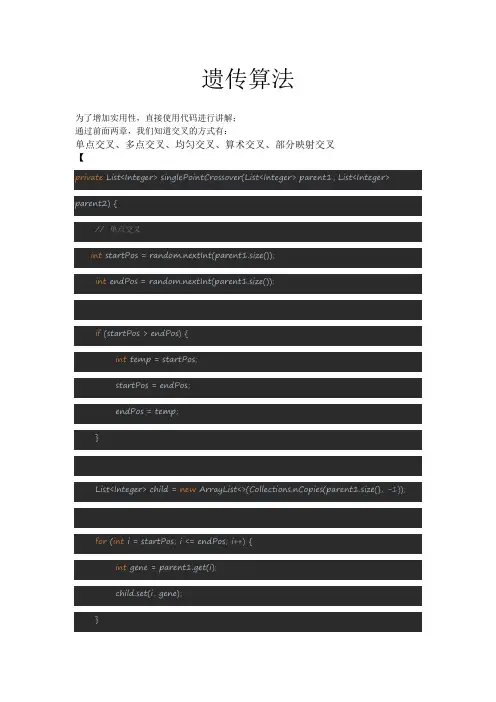
遗传算法为了增加实用性,直接使用代码进行讲解;通过前面两章,我们知道交叉的方式有:单点交叉、多点交叉、均匀交叉、算术交叉、部分映射交叉【private List<Integer> singlePointCrossover(List<Integer> parent1, List<Integer> parent2) {// 单点交叉int startPos = random.nextInt(parent1.size());int endPos = random.nextInt(parent1.size());if (startPos > endPos) {int temp = startPos;startPos = endPos;endPos = temp;}List<Integer> child = new ArrayList<>(Collections.nCopies(parent1.size(), -1));for (int i = startPos; i <= endPos; i++) {int gene = parent1.get(i);child.set(i, gene);}for (int i = 0; i < parent2.size(); i++) {int gene = parent2.get(i);if (!child.contains(gene)) {for (int j = 0; j < child.size(); j++) {if (child.get(j) == -1) {child.set(j, gene);break;}}}}return child;}// 交叉操作(多点交叉)private List<Integer> multiPointCrossover(List<Integer> parent1, List<Integer> parent2) {int startPos = random.nextInt(parent1.size());int endPos = random.nextInt(parent1.size());if (startPos > endPos) {int temp = startPos;startPos = endPos;endPos = temp;}List<Integer> child = new ArrayList<>(parent1.subList(startPos, endPos));for (Integer gene : parent2) {if (!child.contains(gene)) {int insertionIndex = random.nextInt(child.size() + 1);child.add(insertionIndex, gene);}}return child;}// 交叉操作(均匀交叉)private List<Integer> uniformCrossover(List<Integer> parent1, List<Integer> parent2) { List<Integer> child = new ArrayList<>();for (int i = 0; i < parent1.size(); i++) {if (random.nextBoolean()) {child.add(parent1.get(i));} else {child.add(parent2.get(i));}}return child;}// 交叉操作(算术交叉)private List<Integer> arithmeticCrossover(List<Integer> parent1, List<Integer> parent2) {List<Integer> child = new ArrayList<>();for (int i = 0; i < parent1.size(); i++) {int gene1 = parent1.get(i);int gene2 = parent2.get(i);child.add((gene1 + gene2) / 2);}return child;}// 交叉操作(部分映射交叉)private List<Integer> partiallyMappedCrossover(List<Integer> parent1, List<Integer> parent2) {int startPos = random.nextInt(parent1.size());int endPos = random.nextInt(parent1.size());if (startPos > endPos) {int temp = startPos;startPos = endPos;endPos = temp;}List<Integer> child = new ArrayList<>(Collections.nCopies(parent1.size(), -1));for (int i = startPos; i <= endPos; i++) {int gene = parent1.get(i);child.set(i, gene);}for (int i = startPos; i <= endPos; i++) {int gene = parent2.get(i);int index = parent2.indexOf(gene);while (child.get(index) != -1) {gene = parent2.get(index);index = parent2.indexOf(gene);}child.set(index, parent2.get(i));}for (int i = 0; i < parent1.size(); i++) {if (child.get(i) == -1) {child.set(i, parent2.get(i));}}return child;}】。

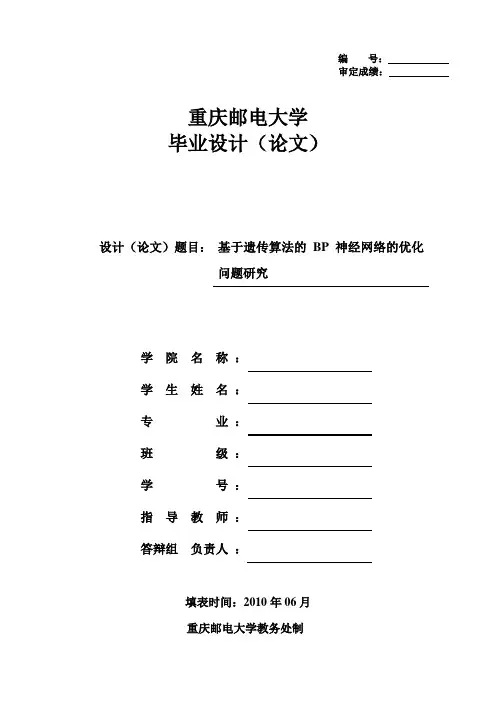
编号:审定成绩:重庆邮电大学毕业设计(论文)设计(论文)题目:基于遗传算法的BP神经网络的优化问题研究学院名称:学生姓名:专业:班级:学号:指导教师:答辩组负责人:填表时间:2010年06月重庆邮电大学教务处制摘要本文的主要研究工作如下:1、介绍了遗传算法的起源、发展和应用,阐述了遗传算法的基本操作,基本原理和遗传算法的特点。
2、介绍了人工神经网络的发展,基本原理,BP神经网络的结构以及BP算法。
3、利用遗传算法全局搜索能力强的特点与人工神经网络模型学习能力强的特点,把遗传算法用于神经网络初始权重的优化,设计出混合GA-BP算法,可以在一定程度上克服神经网络模型训练中普遍存在的局部极小点问题。
4、对某型导弹测试设备故障诊断建立神经网络,用GA直接训练BP神经网络权值,然后与纯BP算法相比较。
再用改进的GA-BP算法进行神经网络训练和检验,运用Matlab软件进行仿真,结果表明,用改进的GA-BP算法优化神经网络无论从收敛速度、误差及精度都明显高于未进行优化的BP神经网络,将两者结合从而得到比现有学习算法更好的学习效果。
【关键词】神经网络BP算法遗传算法ABSTRACTThe main research work is as follows:1. Describing the origin of the genetic algorithm, development and application, explain the basic operations of genetic algorithm, the basic principles and characteristics of genetic algorithms.2. Describing the development of artificial neural network, the basic principle, BP neural network structure and BP.3. Using the genetic algorithm global search capability of the characteristics and learning ability of artificial neural network model with strong features, the genetic algorithm for neural network initial weights of the optimization, design hybrid GA-BP algorithm, to a certain extent, overcome nerves ubiquitous network model training local minimum problem.4. A missile test on the fault diagnosis of neural network, trained with the GA directly to BP neural network weights, and then compared with the pure BP algorithm. Then the improved GA-BP algorithm neural network training and testing, use of Matlab software simulation results show that the improved GA-BP algorithm to optimize neural network in terms of convergence rate, error and accuracy were significantly higher than optimized BP neural network, a combination of both to be better than existing learning algorithm learning.Key words:neural network back-propagation algorithms genetic algorithms目录第一章绪论 (1)1.1 遗传算法的起源 (1)1.2 遗传算法的发展和应用 (1)1.2.1 遗传算法的发展过程 (1)1.2.2 遗传算法的应用领域 (2)1.3 基于遗传算法的BP神经网络 (3)1.4 本章小结 (4)第二章遗传算法 (5)2.1 遗传算法基本操作 (5)2.1.1 选择(Selection) (5)2.1.2 交叉(Crossover) (6)2.1.3 变异(Mutation) (7)2.2 遗传算法基本思想 (8)2.3 遗传算法的特点 (9)2.3.1 常规的寻优算法 (9)2.3.2 遗传算法与常规寻优算法的比较 (10)2.4 本章小结 (11)第三章神经网络 (12)3.1 人工神经网络发展 (12)3.2 神经网络基本原理 (12)3.2.1 神经元模型 (12)3.2.2 神经网络结构及工作方式 (14)3.2.3 神经网络原理概要 (15)3.3 BP神经网络 (15)3.4 本章小结 (21)第四章遗传算法优化BP神经网络 (22)4.1 遗传算法优化神经网络概述 (22)4.1.1 用遗传算法优化神经网络结构 (22)4.1.2 用遗传算法优化神经网络连接权值 (22)4.2 GA-BP优化方案及算法实现 (23)4.3 GA-BP仿真实现 (24)4.3.1 用GA直接训练BP网络的权值算法 (25)4.3.2 纯BP算法 (26)4.3.3 GA训练BP网络的权值与纯BP算法的比较 (28)4.3.4 混合GA-BP算法 (28)4.4 本章小结 (31)结论 (32)致谢 (33)参考文献 (34)附录 (35)1 英文原文 (35)2 英文翻译 (42)3 源程序 (47)第一章绪论1.1 遗传算法的起源从生物学上看,生物个体是由细胞组成的,而细胞则主要由细胞膜、细胞质、和细胞核构成。

摘要近年来,物流作为“第三方利润的源泉”受到国内各行业的极大重视并得到了较大的发展。
在高度发展的商业社会中,传统的VSP算法已无法满足顾客需求对物流配送提出的要求,于是时间窗的概念应运而生。
带有时间窗的车辆优化调度问题是比VSP复杂程度更高的NP难题。
本文在研究物流配送车辆优化调度问题的基础上,对有时间窗的车辆优化调度问题进行了分析。
并对所采用的遗传算法的基本理论做了论述。
对于有时间窗的非满载VSP问题,将货运量约束和软时间窗约束转化为目标约束,建立了非满载VSP模型,设计了基于自然数编码,使用最大保留交叉、改进的反转变异等技术的遗传算法。
经实验分析,取得了较好的结果。
由于此问题为小组成员共同研究,本文重点论述了本人完成的关于适应度函数和变异操作的部分。
关键词:物流配送车辆优化调度遗传算法时间窗AbstractRecent years, logistics, taken as "third profit resource”, has been developing rapidly. In the developed commercial society, traditional VSP algorithm have been unable to meet the requirement that Quick Response to customer demand had brought forth, then the conception of Time Window has come into being. The vehicle-scheduling problem with time window is also a NP-hard problem being more complicated than VSP.This text has been researched to the vehicle-scheduling problem with time window on the basis of researched to logistic vehicle scheduling problem. And it has explained the basic theory of genetic algorithm.On the VSP with time window, while the restraints of capacity and time windows are changed into object restraints, a mathematic model is established. We use technique such as maximum preserved crossover and design genetic algorithm on nature number, which can deal with soft time windows through experimental analysis, have made better result. Because this problem was studied together for group members, this text has expounded the part about fitness function and mutation operator that I finished.Key words:logistic distribution vehicle scheduling problem genetic algorithm time windows目录摘要 (I)Abstract (II)目录......................................................................................................... I II 引言.. (1)第1章概述 (2)1.1研究背景 (2)1.2物流配送车辆优化调度的研究动态和水平 (4)1.2.1 问题的提出 (4)1.2.2 分类 (5)1.2.3 基本问题与基本方法 (6)1.2.4 算法 (6)1.2.5 货运车辆优化调度问题的分类 (8)1.3 研究的意义 (9)1.4 研究的范围 (10)第2章有时间窗的车辆优化调度问题(VSPTW) (11)2.1 时间窗的定义 (11)2.2 VSPTW问题的结构 (13)第3章遗传算法基本理论 (14)3.1 遗传算法的基本原理 (14)3.1.1 遗传算法的特点 (14)3.1.2 遗传算法的基本步骤和处理流程 (15)3.1.3 遗传算法的应用 (16)3.2 编码 (17)3.2.1二进制编码 (18)3.2.2Gray编码 (18)3.2.3实数向量编码 (18)3.2.4排列编码 (19)3.3 适应度函数 (19)3.3.1 目标函数映射成适应度函数 (19)3.3.2 适应度定标 (20)3.4 遗传算法的基因操作 (21)3.4.1 选择算子 (21)3.4.2 交叉算子 (22)3.4.3 变异算子 (25)3.5 遗传算法控制参数设定 (28)第4章遗传算法求解有时间窗非满载VSP (30)4.1 问题描述 (30)4.2 数学模型 (31)4.2.1 一般VSP模型 (31)4.2.2 有时间窗VSP模型 (32)4.3 算法设计 (33)4.3.1 算法流程图 (33)4.3.2 染色体结构 (33)4.3.3 约束处理 (35)4.3.4 适应度函数 (36)4.3.5 初始种群 (36)4.3.6 遗传算子 (36)4.3.7 控制参数和终止条件 (37)4.4 算法实现 (39)4.5 实验及结果分析 (39)4.5.1控制参数选定 (39)4.5.2实例实验 (43)4.5.3实例数据 (44)4.5.4实例数据分析 (44)结论 (45)参考文献 (47)谢辞 (48)引言随着市场经济的发展,大量经营规模较大的制造企业和商业企业纷纷建立起配送中心向商品流通效率化发起挑战,与此同时,相当部分的大型运输、仓储和航运企业开始转向第三方物流经营。
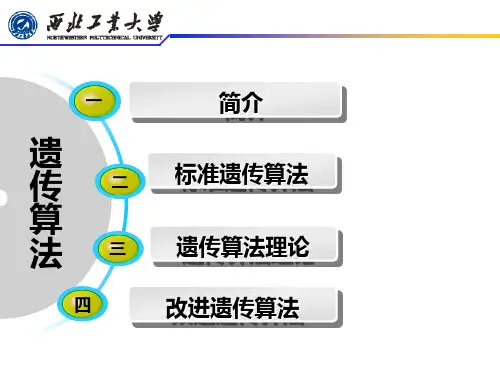

河北工业大学硕士学位论文基于遗传算法的微分方程求解问题的研究姓名:王晓翠申请学位级别:硕士专业:计算机应用技术指导教师:武优西20071101河北工业大学硕士学位论文基于遗传算法的微分方程求解问题的研究摘要遗传算法提供了一种求解非线性、多模型、多目标等复杂系统优化问题的通用框架,它不依赖于问题的具体领域,已经广泛应用于函数优化、组合优化、自动控制、机器学习等科技领域。
自然科学和工程技术中的许多问题被归结为微分方程这一数学形式,而微分方程通常难以解析求解。
本文提出了利用最小二乘原理将微分方程的求解问题转化为求函数最小值的最优化问题,然后利用遗传算法进行进化计算求解常微分和偏微分方程,仿真实验验证了该方法的可行性。
本论文首先分析了课题的研究背景及意义,总结了国内外的研究现状,指出了现阶段求解微分方程的几种方法,并在此基础上进一步确立了利用遗传算法来求解微分方程作为本论文的主要研究内容。
其次,阐述了遗传算法的基本实现机理,并对遗传算法的特点及应用进行了比较详细的叙述,同时简要介绍了MATLAB遗传算法工具箱。
再次,在详细论述了遗传算法理论的基础上,研究了遗传算法在求解微分方程中的应用。
分别介绍了常微分方程及偏微分方程求解问题转化为最优化问题的基本过程,针对常微分方程和偏微分方程分别提出了方程解析解的构造方法,利用遗传算法进行进化计算,并通过实例说明了遗传算法中各个参数的设置方法,最终求得方程的近似最优解。
最后通过具体实例分析了该方法的求解过程,对结果进行了相应的误差分析,验证了该方法的可行性。
最后对本课题的研究进行了总结和进一步展望。
关键词:遗传算法,最优化问题,常微分方程,偏微分方程,构造函数基于遗传算法微分方程求解问题的研究GENETIC ALGORITHM FOR SOLVING ORDINARY AND PARTIAL DIFFERENTIAL EQUATIONSABSTRACTGenetic algorithm brings up a common frame to solve complex system problems, such as non-linear, multi-model, multi-objective and so on. It does not depend on the specific areas of problems and has been applied to many technological areas like functional optimization, combination optimization, auto-control, machine learning. Many problems in natural science and engineering technology could be expressed in a form of differential equations, while it is often difficult to solve that. This article presented a method to transform the problem of solving differential equations to the problem of optimization according to least square principle and some examples were solved to prove it feasible.The paper firstly analyzes the background and meanings of the research work and summarizes the research present situations home and abroad. At the same time, several methods solving differential equations now have been pointed out. Based on above, to solve differential equations with genetic algorithm is established as the main research contents.Secondly, the basic of genetic algorithm is elaborated and its characteristics and applications is detailed, meanwhile it also introduces the tools of genetic algorithm in MATLAB.Thirdly, based on above, genetic algorithm applying to solve differential equations is researched. How to transform the solving problem to optimization problem and how to construct analytical solution is proposed. Also it gives a method to set some parameters through the process solving some examples and the feasibility of the method is illustrated by putting it into solving those examples.At last, the research work is summarized and expected.KEY WORDS: genetic algorithm, optimization problem, ordinary differential equation, partial differential equation, constructed function原创性声明本人郑重声明:所呈交的学位论文,是本人在导师指导下,进行研究工作所取得的成果。
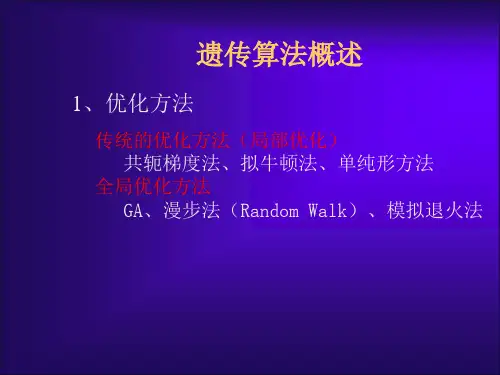
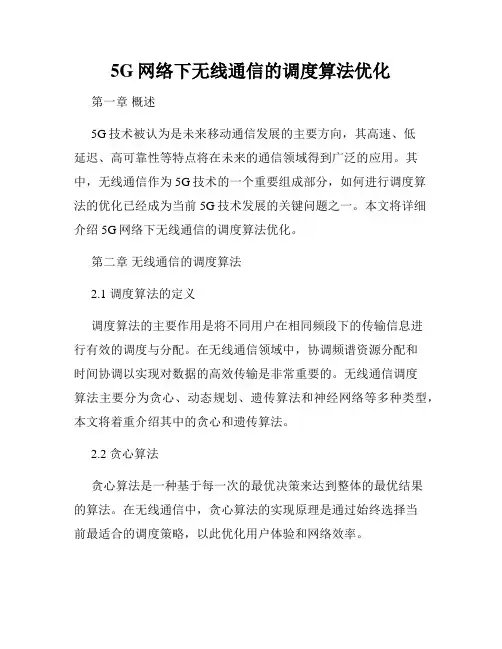
5G网络下无线通信的调度算法优化第一章概述5G技术被认为是未来移动通信发展的主要方向,其高速、低延迟、高可靠性等特点将在未来的通信领域得到广泛的应用。
其中,无线通信作为5G技术的一个重要组成部分,如何进行调度算法的优化已经成为当前5G技术发展的关键问题之一。
本文将详细介绍5G网络下无线通信的调度算法优化。
第二章无线通信的调度算法2.1 调度算法的定义调度算法的主要作用是将不同用户在相同频段下的传输信息进行有效的调度与分配。
在无线通信领域中,协调频谱资源分配和时间协调以实现对数据的高效传输是非常重要的。
无线通信调度算法主要分为贪心、动态规划、遗传算法和神经网络等多种类型,本文将着重介绍其中的贪心和遗传算法。
2.2 贪心算法贪心算法是一种基于每一次的最优决策来达到整体的最优结果的算法。
在无线通信中,贪心算法的实现原理是通过始终选择当前最适合的调度策略,以此优化用户体验和网络效率。
贪心算法的最大优点是具有较快的运算速度,可以在短时间内快速为用户分配频谱资源,确保无线网络的通信质量和效率。
但是,贪心算法往往不考虑长期的网络负载方案,容易产生局部最优解,而忽略全局最优解的存在。
2.3 遗传算法遗传算法是以自然界的进化过程为模板,利用生物的遗传学与进化论的思想开发而成的一种优化搜索算法。
在无线通信中,遗传算法的实现是通过对网络拓扑、用户需求、调度策略等元素进行基因编码,之后通过选择、交叉、变异等过程来产生更优的解决方案。
遗传算法的主要优点是可以全局地搜索最优解,能够克服局部最优解的缺点。
同时,由于其基于多个解决方案,因此可以找到多项解决方案,以保证网络的高效性和稳定性。
第三章 5G网络下无线通信的调度算法优化3.1 频率复用技术在5G网络中,频率复用技术是无线通信中最常见和最有效的优化算法之一。
通过基站站分析和检测周围现有基站的信号强度和整体负载等因素,来对整个网络中频率资源进行合理的管理和分配。
通过调度算法来实现无线资源的优化,提高网络吞吐量,避免频率复用的冲突和瓶颈,从而获得更高的传输效率和更好的用户体验。
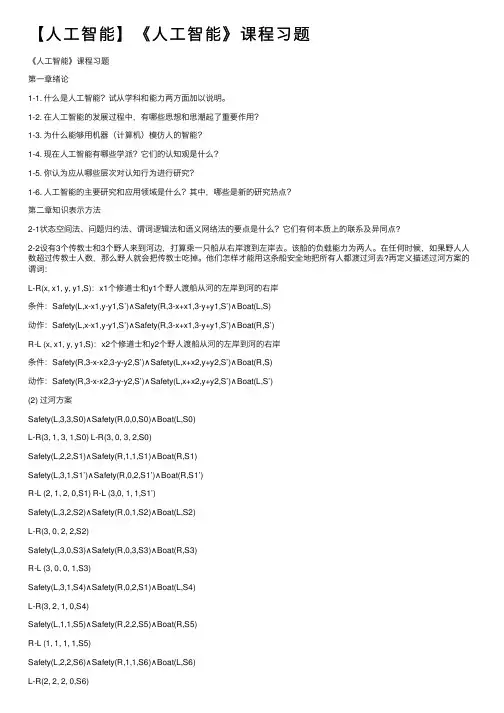
【⼈⼯智能】《⼈⼯智能》课程习题《⼈⼯智能》课程习题第⼀章绪论1-1. 什么是⼈⼯智能?试从学科和能⼒两⽅⾯加以说明。
1-2. 在⼈⼯智能的发展过程中,有哪些思想和思潮起了重要作⽤?1-3. 为什么能够⽤机器(计算机)模仿⼈的智能?1-4. 现在⼈⼯智能有哪些学派?它们的认知观是什么?1-5. 你认为应从哪些层次对认知⾏为进⾏研究?1-6. ⼈⼯智能的主要研究和应⽤领域是什么?其中,哪些是新的研究热点?第⼆章知识表⽰⽅法2-1状态空间法、问题归约法、谓词逻辑法和语义⽹络法的要点是什么?它们有何本质上的联系及异同点?2-2设有3个传教⼠和3个野⼈来到河边,打算乘⼀只船从右岸渡到左岸去。
该船的负载能⼒为两⼈。
在任何时候,如果野⼈⼈数超过传教⼠⼈数,那么野⼈就会把传教⼠吃掉。
他们怎样才能⽤这条船安全地把所有⼈都渡过河去?再定义描述过河⽅案的谓词:L-R(x, x1, y, y1,S):x1个修道⼠和y1个野⼈渡船从河的左岸到河的右岸条件:Safety(L,x-x1,y-y1,S’)∧Safety(R,3-x+x1,3-y+y1,S’)∧Boat(L,S)动作:Safety(L,x-x1,y-y1,S’)∧Safety(R,3-x+x1,3-y+y1,S’)∧Boat(R,S’)R-L (x, x1, y, y1,S):x2个修道⼠和y2个野⼈渡船从河的左岸到河的右岸条件:Safety(R,3-x-x2,3-y-y2,S’)∧Safety(L,x+x2,y+y2,S’)∧Boat(R,S)动作:Safety(R,3-x-x2,3-y-y2,S’)∧Safety(L,x+x2,y+y2,S’)∧Boat(L,S’)(2) 过河⽅案Safety(L,3,3,S0)∧Safety(R,0,0,S0)∧Boat(L,S0)L-R(3, 1, 3, 1,S0) L-R(3, 0, 3, 2,S0)Safety(L,2,2,S1)∧Safety(R,1,1,S1)∧Boat(R,S1)Safety(L,3,1,S1’)∧Safety(R,0,2,S1’)∧Boat(R,S1’)R-L (2, 1, 2, 0,S1) R-L (3,0, 1, 1,S1’)Safety(L,3,2,S2)∧Safety(R,0,1,S2)∧Boat(L,S2)L-R(3, 0, 2, 2,S2)Safety(L,3,0,S3)∧Safety(R,0,3,S3)∧Boat(R,S3)R-L (3, 0, 0, 1,S3)Safety(L,3,1,S4)∧Safety(R,0,2,S1)∧Boat(L,S4)L-R(3, 2, 1, 0,S4)Safety(L,1,1,S5)∧Safety(R,2,2,S5)∧Boat(R,S5)R-L (1, 1, 1, 1,S5)Safety(L,2,2,S6)∧Safety(R,1,1,S6)∧Boat(L,S6)L-R(2, 2, 2, 0,S6)Safety(L,0,2,S7)∧Safety(R,3,1,S7)∧Boat(R,S7)R-L (0, 0, 2, 1,S7)Safety(L,0,3,S8)∧Safety(R,3,0,S8)∧Boat(L,S8)L-R(0, 0, 3, 2,S8)Safety(L,0,1,S9)∧Safety(R,3,2,S9)∧Boat(R,S9)R-L (0, 1, 1, 0,S9)Safety(L,1,1,S10)∧Safety(R,2,2,S10)∧Boat(L,S10)2-3利⽤图2.3,⽤状态空间法规划⼀个最短的旅⾏路程:此旅程从城市A开始,访问其他城市不多于⼀次,并返回A。
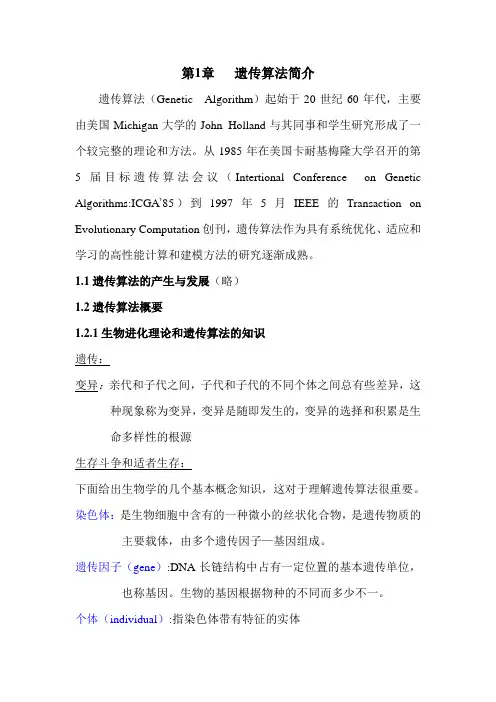
第1章遗传算法简介遗传算法(Genetic Algorithm)起始于20世纪60年代,主要由美国Michigan大学的John Holland与其同事和学生研究形成了一个较完整的理论和方法。
从1985年在美国卡耐基梅隆大学召开的第5届目标遗传算法会议(Intertional Conference on Genetic Algorithms:ICGA’85)到1997年5月IEEE的Transaction on Evolutionary Computation创刊,遗传算法作为具有系统优化、适应和学习的高性能计算和建模方法的研究逐渐成熟。
1.1遗传算法的产生与发展(略)1.2遗传算法概要1.2.1生物进化理论和遗传算法的知识遗传:变异:亲代和子代之间,子代和子代的不同个体之间总有些差异,这种现象称为变异,变异是随即发生的,变异的选择和积累是生命多样性的根源生存斗争和适者生存:下面给出生物学的几个基本概念知识,这对于理解遗传算法很重要。
染色体:是生物细胞中含有的一种微小的丝状化合物,是遗传物质的主要载体,由多个遗传因子—基因组成。
遗传因子(gene):DNA长链结构中占有一定位置的基本遗传单位,也称基因。
生物的基因根据物种的不同而多少不一。
个体(individual):指染色体带有特征的实体种群(population):染色体带有特征的个体的集合进化(evolution);生物在其延续生命的过程中,逐渐适应其生存环境使得其品质不断得到改良,这种生命现象称为进化。
生物的进化是以种群的形式进行的。
适应度(fitness):度量某个物种对于生存环境的适应程度选择(selection):指以一定的概率从种群中选择若干个体的操作复制(reproduction)交叉(crossorer)变异(musation):复制时很小的概率产生的某些复制差错编码(coding):DNA中遗传信息在一个长链上按一定的模式排列,也即进行了遗传编码。
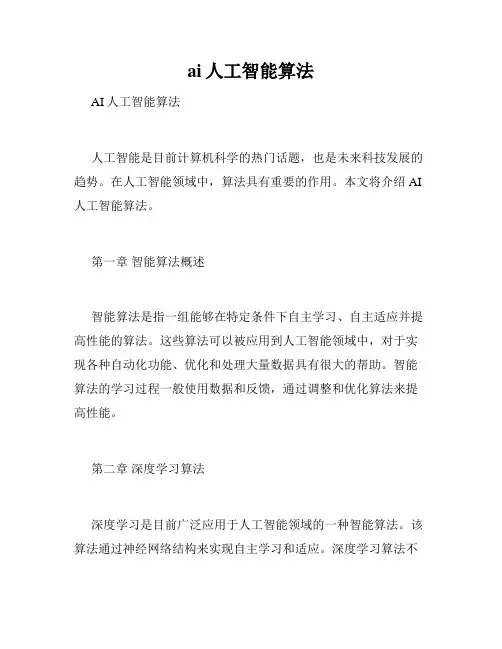
ai人工智能算法AI人工智能算法人工智能是目前计算机科学的热门话题,也是未来科技发展的趋势。
在人工智能领域中,算法具有重要的作用。
本文将介绍AI 人工智能算法。
第一章智能算法概述智能算法是指一组能够在特定条件下自主学习、自主适应并提高性能的算法。
这些算法可以被应用到人工智能领域中,对于实现各种自动化功能、优化和处理大量数据具有很大的帮助。
智能算法的学习过程一般使用数据和反馈,通过调整和优化算法来提高性能。
第二章深度学习算法深度学习是目前广泛应用于人工智能领域的一种智能算法。
该算法通过神经网络结构来实现自主学习和适应。
深度学习算法不仅可以在文本、图像和视频等领域取得很好的效果,也在自动驾驶、机器人和自然语言处理等领域中具有广泛的应用。
第三章机器学习算法机器学习是指利用数据和特定算法让机器进行学习和适应的过程。
机器学习算法可以被分类为三类:监督学习、无监督学习和半监督学习。
监督学习旨在预测未来的结果,无监督学习则是发现数据的结构和模式,半监督学习则是结合监督和无监督学习。
第四章遗传算法遗传算法是仿照自然选择过程构建出的一种优化算法。
遗传算法包括三个基本操作:选择(Selection),交叉(Crossover)和变异(Mutation)。
遗传算法的优势在于它可以在搜索空间非常大的情况下,找到全局最优解。
第五章推荐算法推荐算法是指根据用户历史行为和特定的算法,对用户进行个性化的推荐。
这种算法可以被应用于电子商务、社交网络和搜索引擎等领域。
推荐算法常用的方法包括协同过滤(Collaborative Filtering)、内容过滤和混合过滤。
第六章结语本文对AI人工智能算法进行了介绍。
智能算法在人工智能领域中发挥着重要作用。
深度学习算法、机器学习算法、遗传算法和推荐算法是AI人工智能算法的重要代表。
在未来的发展中,这些算法将继续不断地推进人工智能技术的发展。
《遗传算法原理及应用》课程教学大纲课程名称:遗传算法原理及应用课程类别:任意选修课适用专业:电子信息工程考核方式:考查总学时、学分:24学时1.5学分一、课程性质、教学目标遗传算法原理及应用是电子信息工程专业的一门任意选修课。
通过本门课的学习,要求学生理解基本遗传算法的特点、思想及其实现过程,了解GA的发展及其应用,熟悉MATLAB遗传算法工具箱函数及其初步应用,并不断提高分析和解决具体问题的能力。
该课程主要包括基本遗传算法,遗传算法的基本、高级实现技术,并行遗传算法,遗传算法的数学理论及应用等。
本门课程与《数字图像处理》、《人工神经网络》、《机器学习与应用》等专业选修课程内容具有较强的相关性和融合性。
其具体的课程教学目标为:课程教学目标1:了解遗传算法的特点、发展及应用。
课程教学目标2:理解GA的基本实现方法以及一些高级实现技术。
理解模式和模式定理;了解评价遗传算法的一些常用测试函数。
课程教学目标3:了解遗传算法在数值函数优化、多目标优化、装箱、旅行商等问题中的应用。
课程教学目标与毕业要求对应的矩阵关系二、课程教学要求遗传算法是模拟生物在自然环境中的遗传和进化过程而形成的一种自适应全局优化概率搜索算法。
通过本课程的学习,使学生了解遗传算法的生物学基础、特点、发展及应用;理解SGA、GA的一些基本及高级实现技术;掌握模式的概念和模式定理的含义;了解进行遗传算法评价的常用测试函数,SGA的收敛性分析;了解遗传算法在多领域中的应用。
三、先修课程高等数学、算法与数据结构、计算机基础与应用、计算机仿真(Matlab和Multisim)等。
四、课程教学重、难点教学重点:遗传算法的各种基本编码方法、适应度函数、选择算子、交叉算子、变异算子;教学难点:GA倒位算子及二倍体显性操作算子的基本实现; GA 的运行参数和约束条件的处理方法;变长度染色体遗传算法、小生境遗传算法和混合遗传算法的基本思想。
五、课程教学方法与教学手段本课程以课堂讲授、讨论、交流为主,课下自学为辅。
遗传算法综述遗传算法是计算数学中用于解决最优化的搜索算法,是进化算法的一种。
进化算法最初是借鉴了进化生物学中的一些现象而发展起来的,这些现象包括遗传、突变、自然选择以及杂交等。
在阅读了一些相关资料后,我整理出这篇综述,将通过五个部分来介绍遗传算法以及其在计算机科学领域的相关应用、一、起源和发展分支尝试性地将生物进化过程在计算机中模拟并用于优化问题求解开始于20世纪50年代末,其目的是将生物进化的思想引入许多工程问题中而成为一种优化工具,这些开拓性的研究工作形成了遗传算法的雏形。
但当时的研究进展缓慢,收效甚微。
原因是由于缺少一种通用的编码方式,人们只有通过变异才能改变基因结构,而无法使用交叉,因而增加了迭代次数。
同时算法本身需要较大的计算量,当时的计算机速度便无法满足要求,因而限制了这一仿生过程技术的迅速发展。
20世纪60年代中期,Holland在Fraser和Bremermann等人研究成果的基础上提出了位串编码技术,这种编码技术同时适用于变异操作和交叉操作。
遗传算法的真正产生源于20世纪60年代末到70年代初,美国Michigan大学的Holland教授在设计人工适应系统中开创性地使用了一种基于自然演化原理的搜索机制,并于1975年出版了著名的专著“Adaptation in Natural andArtificial Systems”,这些有关遗传算法的基础理论为遗传算法的发展和完善奠定了的基础。
同时,Holland教授的学生De Jong首次将遗传算法应用于函数优化中,设计了遗传算法执行策略和性能评价指标,他挑选的5个专门用于遗传算法数值实验的函数至今仍被频繁使用,而他提出的在线(on-line)和离线(off-line)指标则仍是目前衡量遗传算法优化性能的主要手段。
在Holland教授和他的学生与同事De Jong进行大量有关遗传算法的开创性工作的同时,德国柏林工业大学的Rechenberg和Schwefel等在进行风洞实验时,为了对描述物体形状的参数进行优化以获得更好的实验数据,将变异操作引入计算模型中,获得了意外的优良效果。
遗传算法 matlab这篇文章主要讨论了遗传算法在MATLAB中的应用。
首先,文章讨论了遗传算法的概念,其核心原理和优缺点。
接下来,文章讨论了MATLAB支持的遗传算法的功能,以及如何使用MATLAB实现遗传算法。
最后,文章给出了三个关于遗传算法在MATLAB中的应用的案例,以说明MATLAB的功能。
综上所述,这篇文章详细讨论了遗传算法在MATLAB中的应用,并解释了使用MATLAB进行遗传算法的步骤。
1言计算机仿生技术以及其伴随的算法技术是当今计算机科学研究中越来越重要的主题,它可以帮助解决复杂或者没有定义明确解出的问题。
通过模仿生物进化的过程,遗传算法可以解决一类较复杂的优化问题,其中遗传算法是机器学习中最重要的算法之一。
本文将会讨论遗传算法在MATLAB中的应用,并解释MATLAB如何实现遗传算法。
2传算法2.1念遗传算法(Genetic Algorithm,简称GA)是一种根据自然进化规律而发展起来的著名搜索算法,被认为是一种在无精确解法或数值计算方法可行时,以模拟生物进化过程为基础的概率式算法,它能够用各种形式的优化问题来进行查找或搜索。
2.2心原理GA的核心原理是通过自然选择和遗传进化的过程寻找最优解。
GA用操作符模拟自然选择的过程,如:选择,交叉,变异,突变等,而编码技术则模拟遗传进化的载体基因的传播。
2.3 优缺点GA算法的优点在于,不需要求解问题的函数,只需要设定一个评价函数,可以实现大量参数约束和非线性优化问题的求解;而且,相对其他算法,GA算法具有更高的收敛速度和更好的最优解。
然而,GA同时也存在一些缺点,包括容易陷入局部最优解,基因编解码模型以及参数搜索空间较大等问题。
3 MATLAB支持的遗传算法MATLAB支持多种遗传算法,其中包括:使用遗传算法拟合曲线函数;使用遗传算法搜索空间中的最优解;使用基于自适应遗传算法解决优化问题;使用遗传算法搜索前景图中的最优路径等。
4何使用MATLAB进行遗传算法下面给出了一般使用遗传算法的步骤:第一步:初始化种群。
基于遗传算法的变电站配置优化分析随着社会对能源需求的不断增加,电力系统的规模和复杂度也越来越大。
在电力系统中,变电站是枢纽性的电力设施,它起着能量转化、输送和分配等重要作用。
因此,变电站的配置对电力系统的运行安全和经济效益具有重要影响。
随着电力系统的快速发展,变电站配置的优化成为一项重要的研究领域。
本文将探讨基于遗传算法的变电站配置优化分析。
第一章引言电力系统是一个复杂的系统,包括发电厂、输电线路、变电站等组成部分。
在这些组成部分中,变电站是连接电网的要地之一,因此,变电站的配置对电力系统的安全和经济运行都具有至关重要的作用。
目前,国内外学者对变电站的配置优化问题进行了广泛研究。
在这些研究中,遗传算法是一种常用的求解方法。
第二章变电站配置问题简介变电站配置问题是指如何确定变电站的位置、规模、结构、装备等参数,以达到给定的电力系统运行要求。
该问题的优化目标一般是以全系统运行费用最小为目标。
变电站配置的问题有多个目标、多个约束,同时又涉及到不同来源、类型、质量的目标和约束。
第三章遗传算法遗传算法(GA)是一种受生物学启发的优化算法,由美国加州大学的杰出计算机科学家约翰·霍兰德(John Holland)在20世纪60年代提出。
它是一种基于种群的启发式优化方法,通过对一组个体的进化和遗传进行模拟,不断更新和改进解空间中的候选解,从而达到寻求优化解的目的。
遗传算法的基本过程如下:1. 初始化种群:随机生成初始的种群。
2. 选择操作:按照适应度大小对种群进行选择,以确保较优的个体得到保留。
3. 交叉操作:从父代中选择两个个体进行基因交叉(crossover),产生两个新的个体。
4. 变异操作:随机选择若干个体,改变其某个基因,以增加种群的多样性。
5. 评价操作:计算每个个体的适应度,评价各个个体的生存状况。
6. 判断终止条件:判断是否达到终止条件,否则返回第2步。
第四章基于遗传算法的变电站配置优化针对变电站配置问题,可以设计适应度函数来衡量每个解的优劣。
电磁场中的遗传算法优化第一章绪论电磁场是物理学中的重要分支,涉及到电磁波、电磁力和电磁感应等丰富的现象。
在实际应用中,我们常遇到需要对电磁场进行优化控制的情况。
而遗传算法是一种利用自然选择、交叉、变异等机制进行优化的算法,已在众多领域得到广泛应用。
本文将介绍电磁场中的遗传算法优化,并分析其应用实例。
第二章电磁场中的遗传算法在处理电磁场优化问题时,遗传算法是一个有力的工具。
遗传算法是一个基于生物进化理论的机器智能算法,通过模拟生物进化的过程,逐步优化出较好的解决方案。
在电磁场问题中,遗传算法可以通过逐步调整各项参数,得到更优秀的电磁场解。
第三章应用实例3.1 核磁共振成像核磁共振成像是一种常见的医学成像技术,其基本原理是利用磁共振现象,对人体进行无创检查。
在核磁共振成像过程中,需要产生比较强的磁场,这个磁场的大小和方向对成像效果至关重要。
通过使用遗传算法,在核磁共振成像中成功优化了磁场强度和磁场方向,从而获得了更好的成像效果。
3.2 电磁场的建模电磁场的建模是一个复杂而关键的步骤。
在很多电磁场问题中,需要对复杂的几何体进行建模,并对电磁场进行计算。
而这个过程中,各项参数的设置对计算结果有非常大的影响。
使用遗传算法,在电磁场建模中得到了较好的优化效果。
通过逐步调整各项参数,可以得到更接近于实际情况的模型,从而提高计算结果的精确度和可靠性。
第四章结论本文介绍了电磁场中的遗传算法优化,并分析了其应用实例。
在电磁场问题中,遗传算法可以逐步优化各项参数,从而得到更好的解决方案。
在实际应用中,遗传算法已得到广泛应用,并取得了良好的效果。